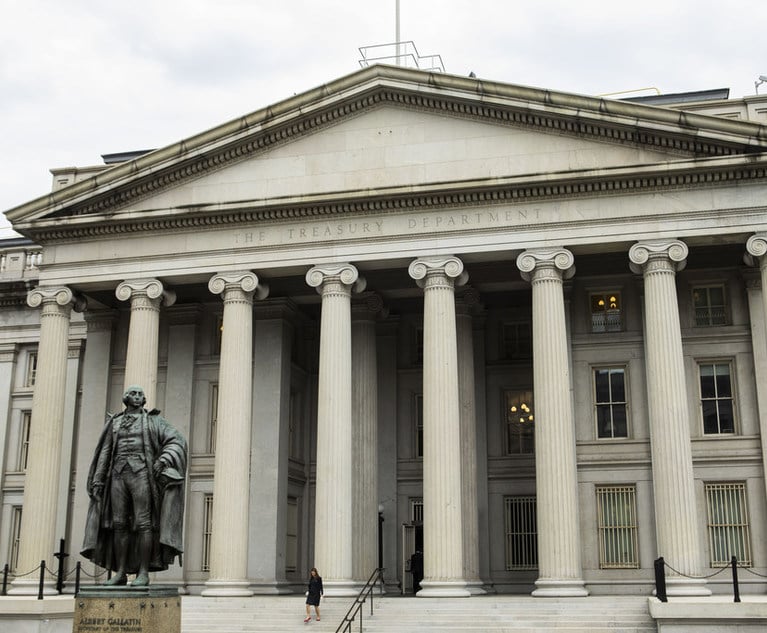Regulatory: Financial regulators regulate themselves over who they will regulate
In order to provide clarity and transparency, the Consumer Financial Protection Bureau (Bureau) and the Prudential Regulators jointly issued a supervisory statement addressing agency jurisdiction over the largest banks and credit unions in the United States
November 30, 2011 at 04:00 AM
4 minute read
The original version of this story was published on Law.com
This column is part a series of articles on the new Consumer Financial Protection Bureau and the upcoming wave of regulations affecting the consumer financial industry
In order “to provide clarity and transparency,” the Consumer Financial Protection Bureau (Bureau) and the Prudential Regulators—the Federal Reserve Board, the Federal Deposit Insurance Corporation (FDIC), the Office of the Comptroller of the Currency and the National Credit Union Administration—jointly issued a supervisory statement addressing agency jurisdiction over the largest banks and credit unions in the United States.
The Dodd-Frank Wall Street Reform and Consumer Protection Act (Dodd-Frank Act), while sweeping in scope, left unanswered some critical questions about which regulator regulates certain financial institutions and when.
For purposes of the federal consumer financial protection laws, Section 1025 of the Dodd-Frank Act gives the Bureau exclusive supervisory authority and primary enforcement authority over financial institutions that have total assets over $10 billion (so-called large institutions), as well as any of their affiliates. Section 1026 of the Dodd-Frank Act dictates that, for all other financial institutions, the Prudential Regulators will retain supervisory and enforcement authority when it comes to consumer financial protection.
The missing pieces of this jurisdictional puzzle are how and when to determine whether a financial institution has $10 billion in assets. Because the Dodd-Frank Act is silent on the issue, the Prudential Regulators and the Bureau got together on their own to set appropriate policies and procedures. In order to do so, the agencies needed to determine how to measure the size of financial institutions and when to take that measurement.
As to the former, the agencies found that Section 7(a)(3) of the Federal Deposit Insurance Act requires financial institutions to file Call Reports on a quarterly basis, which provide an account of the condition of the institution, including a disclosure of its total assets. Because this measure is the most common measure of asset size, the agencies determined that it was therefore “appropriate” to use Call Reports to determine size for the purposes of Sections 1025 and 1026 of the Dodd-Frank Act.
With respect to the timing of size measurements, the agencies were properly concerned about avoiding undue uncertainty and volatility in the identification of a financial institution's primary regulator. Imagine if an institution regularly teetered on the $10 billion threshold. Would it report one day to its Prudential Regulator and the next to the Bureau?
The agencies duly avoided this untenable situation by deciding to look at Call Reports for four consecutive quarters before changing an institution's status. Thus, if an institution reports $10 billion in assets for four quarters in a row, then it is a large institution for purposes of Sections 1025 and 1026; if it reports under $10 billion, it is not. The FDIC has a long-standing history of using this precise method, which provides some continuity and certainty to a regulatory regime that is in such an extended state of flux at the moment.
When will the first measurements take place? Well, unbeknownst to anyone, they have already. Notwithstanding the very recent announcement regarding these issues, the agencies have decided to use Call Reports from June 30, 2011 as the starting place. The agencies rationalized this decision because June 30, 2011 is the closest Call Report date to the date that authority for the federal consumer protection laws was transferred to the Bureau (the “Designated Transfer Date” was July 21, 2011).
If an institution reported $10 billion in assets as of June 30, then it is a Large Institution for purposes of Sections 1025 and 1026 of the Dodd-Frank Act. Subsequently, as noted, a bank or credit union will not cross back and forth across the large institution line unless it sustains or fails to sustain $10 billion in assets for at least a year's worth of Call Reports.
This content has been archived. It is available through our partners, LexisNexis® and Bloomberg Law.
To view this content, please continue to their sites.
Not a Lexis Subscriber?
Subscribe Now
Not a Bloomberg Law Subscriber?
Subscribe Now
NOT FOR REPRINT
© 2025 ALM Global, LLC, All Rights Reserved. Request academic re-use from www.copyright.com. All other uses, submit a request to [email protected]. For more information visit Asset & Logo Licensing.
You Might Like
View All
Internal Whistleblowing Surged Globally in 2024, So Why Were US Numbers Flat?
6 minute read
FTC Finalizes Child Online Privacy Rule Updates, But Ferguson Eyes Further Changes

Supreme Court Reinstates Corporate Disclosure Law Pending Challenge
Trending Stories
- 1New York-Based Skadden Team Joins White & Case Group in Mexico City for Citigroup Demerger
- 2No Two Wildfires Alike: Lawyers Take Different Legal Strategies in California
- 3Poop-Themed Dog Toy OK as Parody, but Still Tarnished Jack Daniel’s Brand, Court Says
- 4Meet the New President of NY's Association of Trial Court Jurists
- 5Lawyers' Phones Are Ringing: What Should Employers Do If ICE Raids Their Business?
Who Got The Work
J. Brugh Lower of Gibbons has entered an appearance for industrial equipment supplier Devco Corporation in a pending trademark infringement lawsuit. The suit, accusing the defendant of selling knock-off Graco products, was filed Dec. 18 in New Jersey District Court by Rivkin Radler on behalf of Graco Inc. and Graco Minnesota. The case, assigned to U.S. District Judge Zahid N. Quraishi, is 3:24-cv-11294, Graco Inc. et al v. Devco Corporation.
Who Got The Work
Rebecca Maller-Stein and Kent A. Yalowitz of Arnold & Porter Kaye Scholer have entered their appearances for Hanaco Venture Capital and its executives, Lior Prosor and David Frankel, in a pending securities lawsuit. The action, filed on Dec. 24 in New York Southern District Court by Zell, Aron & Co. on behalf of Goldeneye Advisors, accuses the defendants of negligently and fraudulently managing the plaintiff's $1 million investment. The case, assigned to U.S. District Judge Vernon S. Broderick, is 1:24-cv-09918, Goldeneye Advisors, LLC v. Hanaco Venture Capital, Ltd. et al.
Who Got The Work
Attorneys from A&O Shearman has stepped in as defense counsel for Toronto-Dominion Bank and other defendants in a pending securities class action. The suit, filed Dec. 11 in New York Southern District Court by Bleichmar Fonti & Auld, accuses the defendants of concealing the bank's 'pervasive' deficiencies in regards to its compliance with the Bank Secrecy Act and the quality of its anti-money laundering controls. The case, assigned to U.S. District Judge Arun Subramanian, is 1:24-cv-09445, Gonzalez v. The Toronto-Dominion Bank et al.
Who Got The Work
Crown Castle International, a Pennsylvania company providing shared communications infrastructure, has turned to Luke D. Wolf of Gordon Rees Scully Mansukhani to fend off a pending breach-of-contract lawsuit. The court action, filed Nov. 25 in Michigan Eastern District Court by Hooper Hathaway PC on behalf of The Town Residences LLC, accuses Crown Castle of failing to transfer approximately $30,000 in utility payments from T-Mobile in breach of a roof-top lease and assignment agreement. The case, assigned to U.S. District Judge Susan K. Declercq, is 2:24-cv-13131, The Town Residences LLC v. T-Mobile US, Inc. et al.
Who Got The Work
Wilfred P. Coronato and Daniel M. Schwartz of McCarter & English have stepped in as defense counsel to Electrolux Home Products Inc. in a pending product liability lawsuit. The court action, filed Nov. 26 in New York Eastern District Court by Poulos Lopiccolo PC and Nagel Rice LLP on behalf of David Stern, alleges that the defendant's refrigerators’ drawers and shelving repeatedly break and fall apart within months after purchase. The case, assigned to U.S. District Judge Joan M. Azrack, is 2:24-cv-08204, Stern v. Electrolux Home Products, Inc.
Featured Firms
Law Offices of Gary Martin Hays & Associates, P.C.
(470) 294-1674
Law Offices of Mark E. Salomone
(857) 444-6468
Smith & Hassler
(713) 739-1250







